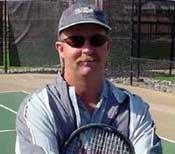<% ns_puts [mkm_getnavbar] %>

The “Advanced Foundation”
Advancing to the Next Level!
By David W. Smith (Excerpted from his book, Tennis Mastery, due out in early Fall, 2003)
Tennis, perhaps more than any other sport, has two distinct “classes” of players: in one court there are those who progressively improve and reach what is generally recognized as “accomplished” or “skilled” levels of play. On the other side are those who learn basic skills, then promptly stagnate at a particular ability level, usually at the 3.0 or 3.5 NTRP levels. (To those just starting out, the NTRP—National Tennis Rating Program—levels go from a 1.0 beginner to a 7.0 professional.)
To the untrained eye or to an inexperienced individual this distinction of two classes may be difficult to recognize. However, there are countless tennis players who have played for years, if not decades, who have not advanced significantly!
|
|
Of the 12 million tennis players in the United States more than three-quarters seem to reside permenantly at the 3.0 or 3.5 level or below. This statement is not meant to offend anyone or insinuate that players at these levels are incapable of playing high-level tennis. On the contrary, it is my intention to prove that virtually all players, including those who currently reside at the 3.0 or 3.5 levels, are indeed perfectly capable of playing higher levels of tennis… much higher!
This distinction of two classes of players has created an identifiable vernacular within tennis circles. Players refer to “The Big Four-O (4.0 NTRP level)” as being a major stepping stone, a hurdle one needs to vault in order to be recognized as a skilled player. Countless 3.5 level players spend millions of dollars each year in search of ways in which they can “break through” this 3.5 barricade. The question is why do some break through while others have to resign themselves to “mediocrity” for life? (With the NTRP levels starting at 1.0 and topping out at 7.0, the levels 3.0 and 3.5 are technically considered below average on this scale. Because so many players are stuck at these levels, many consider these levels to be “average!”)
Many variables can account for such stagnation including lack of desire, lack of natural athleticism, limited playing opportunities, or a lack of available tennis information. However, it is interesting to recognize that the majority of those players who stopped improving did indeed have similar desires, adequate athleticism, an access to tennis information, and similar playing opportunities to those who continued to improve. If these things are indeed similar between the two classes of players, what factor can be identified as the decisive divergent mechanism? If all things are considered equal, then the answer becomes quite evident. The only recognizable variable, which in this case is indeed a variable, is information!
To read the rest of Dave Smith's article, click here to register for your free 30 day membership at TennisONE.
 Your comments are welcome. Let us know what you think about this article by emailing
us here at TennisONE.
Your comments are welcome. Let us know what you think about this article by emailing
us here at TennisONE.
David W. Smith is the Director of Tennis for the St. George Tennis Academy
in St. George Utah. He has been a featured writer in USPTA’s magazine
ADDvantage in addition to having over 50 published articles in various
publications. David has taught over 3000 players including many top
national and world ranked players. He can be reached at ACRpres1@msn.com
To contact us, please email to: webmaster@tennisone.com
TennisONE is a registered trademark of TennisONE and SportsWeb ONE; Copyright 1995. All rights reserved.

